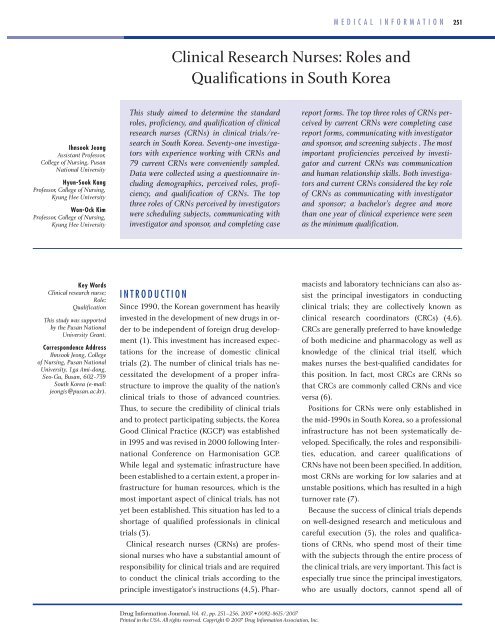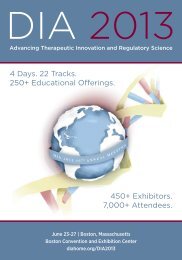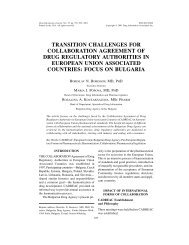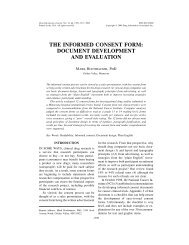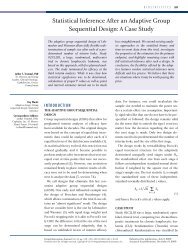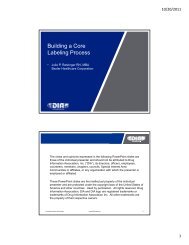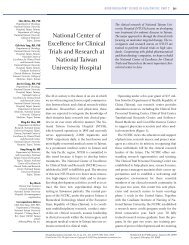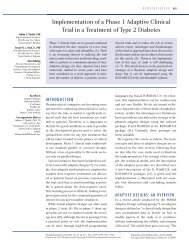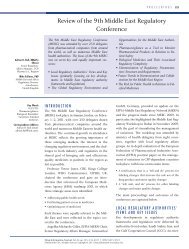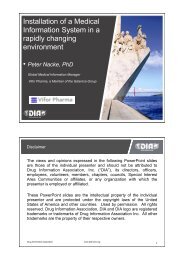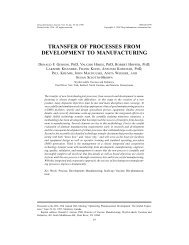Clinical Research Nurses: Roles and Qualifications in South Korea
Clinical Research Nurses: Roles and Qualifications in South Korea
Clinical Research Nurses: Roles and Qualifications in South Korea
Create successful ePaper yourself
Turn your PDF publications into a flip-book with our unique Google optimized e-Paper software.
Ihnsook Jeong<br />
Assistant Professor,<br />
College of Nurs<strong>in</strong>g, Pusan<br />
National University<br />
Hyun-Sook Kang<br />
Professor, College of Nurs<strong>in</strong>g,<br />
Kyung Hee University<br />
Won-Ock Kim<br />
Professor, College of Nurs<strong>in</strong>g,<br />
Kyung Hee University<br />
Key Words<br />
<strong>Cl<strong>in</strong>ical</strong> research nurse;<br />
Role;<br />
Qualification<br />
This study was supported<br />
by the Pusan National<br />
University Grant.<br />
Correspondence Address<br />
Ihnsook Jeong, College<br />
of Nurs<strong>in</strong>g, Pusan National<br />
University, 1ga Ami-dong,<br />
Seo-Gu, Busan, 602-739<br />
<strong>South</strong> <strong>Korea</strong> (e-mail:<br />
jeongis@pusan.ac.kr).<br />
<strong>Cl<strong>in</strong>ical</strong> <strong>Research</strong> <strong>Nurses</strong>: <strong>Roles</strong> <strong>and</strong><br />
<strong>Qualifications</strong> <strong>in</strong> <strong>South</strong> <strong>Korea</strong><br />
This study aimed to determ<strong>in</strong>e the st<strong>and</strong>ard<br />
roles, proficiency, <strong>and</strong> qualification of cl<strong>in</strong>ical<br />
research nurses (CRNs) <strong>in</strong> cl<strong>in</strong>ical trials/research<br />
<strong>in</strong> <strong>South</strong> <strong>Korea</strong>. Seventy-one <strong>in</strong>vestigators<br />
with experience work<strong>in</strong>g with CRNs <strong>and</strong><br />
79 current CRNs were conveniently sampled.<br />
Data were collected us<strong>in</strong>g a questionnaire <strong>in</strong>clud<strong>in</strong>g<br />
demographics, perceived roles, proficiency,<br />
<strong>and</strong> qualification of CRNs. The top<br />
three roles of CRNs perceived by <strong>in</strong>vestigators<br />
were schedul<strong>in</strong>g subjects, communicat<strong>in</strong>g with<br />
<strong>in</strong>vestigator <strong>and</strong> sponsor, <strong>and</strong> complet<strong>in</strong>g case<br />
INTRODUCTION<br />
S<strong>in</strong>ce 1990, the <strong>Korea</strong>n government has heavily<br />
<strong>in</strong>vested <strong>in</strong> the development of new drugs <strong>in</strong> order<br />
to be <strong>in</strong>dependent of foreign drug development<br />
(1). This <strong>in</strong>vestment has <strong>in</strong>creased expectations<br />
for the <strong>in</strong>crease of domestic cl<strong>in</strong>ical<br />
trials (2). The number of cl<strong>in</strong>ical trials has necessitated<br />
the development of a proper <strong>in</strong>frastructure<br />
to improve the quality of the nation’s<br />
cl<strong>in</strong>ical trials to those of advanced countries.<br />
Thus, to secure the credibility of cl<strong>in</strong>ical trials<br />
<strong>and</strong> to protect participat<strong>in</strong>g subjects, the <strong>Korea</strong><br />
Good <strong>Cl<strong>in</strong>ical</strong> Practice (KGCP) was established<br />
<strong>in</strong> 1995 <strong>and</strong> was revised <strong>in</strong> 2000 follow<strong>in</strong>g International<br />
Conference on Harmonisation GCP.<br />
While legal <strong>and</strong> systematic <strong>in</strong>frastructure have<br />
been established to a certa<strong>in</strong> extent, a proper <strong>in</strong>frastructure<br />
for human resources, which is the<br />
most important aspect of cl<strong>in</strong>ical trials, has not<br />
yet been established. This situation has led to a<br />
shortage of qualified professionals <strong>in</strong> cl<strong>in</strong>ical<br />
trials (3).<br />
<strong>Cl<strong>in</strong>ical</strong> research nurses (CRNs) are professional<br />
nurses who have a substantial amount of<br />
responsibility for cl<strong>in</strong>ical trials <strong>and</strong> are required<br />
to conduct the cl<strong>in</strong>ical trials accord<strong>in</strong>g to the<br />
pr<strong>in</strong>ciple <strong>in</strong>vestigator’s <strong>in</strong>structions (4,5). Phar-<br />
Drug Information Journal, Vol. 41, pp. 251–256, 2007 • 0092-8615/2007<br />
Pr<strong>in</strong>ted <strong>in</strong> the USA. All rights reserved. Copyright © 2007 Drug Information Association, Inc.<br />
MEDICAL INFORMATION<br />
report forms. The top three roles of CRNs perceived<br />
by current CRNs were complet<strong>in</strong>g case<br />
report forms, communicat<strong>in</strong>g with <strong>in</strong>vestigator<br />
<strong>and</strong> sponsor, <strong>and</strong> screen<strong>in</strong>g subjects . The most<br />
important proficiencies perceived by <strong>in</strong>vestigator<br />
<strong>and</strong> current CRNs was communication<br />
<strong>and</strong> human relationship skills. Both <strong>in</strong>vestigators<br />
<strong>and</strong> current CRNs considered the key role<br />
of CRNs as communicat<strong>in</strong>g with <strong>in</strong>vestigator<br />
<strong>and</strong> sponsor; a bachelor’s degree <strong>and</strong> more<br />
than one year of cl<strong>in</strong>ical experience were seen<br />
as the m<strong>in</strong>imum qualification.<br />
251<br />
macists <strong>and</strong> laboratory technicians can also assist<br />
the pr<strong>in</strong>cipal <strong>in</strong>vestigators <strong>in</strong> conduct<strong>in</strong>g<br />
cl<strong>in</strong>ical trials; they are collectively known as<br />
cl<strong>in</strong>ical research coord<strong>in</strong>ators (CRCs) (4,6).<br />
CRCs are generally preferred to have knowledge<br />
of both medic<strong>in</strong>e <strong>and</strong> pharmacology as well as<br />
knowledge of the cl<strong>in</strong>ical trial itself, which<br />
makes nurses the best-qualified c<strong>and</strong>idates for<br />
this position. In fact, most CRCs are CRNs so<br />
that CRCs are commonly called CRNs <strong>and</strong> vice<br />
versa (6).<br />
Positions for CRNs were only established <strong>in</strong><br />
the mid-1990s <strong>in</strong> <strong>South</strong> <strong>Korea</strong>, so a professional<br />
<strong>in</strong>frastructure has not been systematically developed.<br />
Specifically, the roles <strong>and</strong> responsibilities,<br />
education, <strong>and</strong> career qualifications of<br />
CRNs have not been been specified. In addition,<br />
most CRNs are work<strong>in</strong>g for low salaries <strong>and</strong> at<br />
unstable positions, which has resulted <strong>in</strong> a high<br />
turnover rate (7).<br />
Because the success of cl<strong>in</strong>ical trials depends<br />
on well-designed research <strong>and</strong> meticulous <strong>and</strong><br />
careful execution (5), the roles <strong>and</strong> qualifications<br />
of CRNs, who spend most of their time<br />
with the subjects through the entire process of<br />
the cl<strong>in</strong>ical trials, are very important. This fact is<br />
especially true s<strong>in</strong>ce the pr<strong>in</strong>cipal <strong>in</strong>vestigators,<br />
who are usually doctors, cannot spend all of
252 MEDICAL INFORMATION<br />
Jeong, Kang, Kim<br />
their time on the cl<strong>in</strong>ical trial, which leaves the<br />
CRNs to spend most of their time on the cl<strong>in</strong>ical<br />
trial (8–10).<br />
Regard<strong>in</strong>g this background, it is necesary to<br />
set up st<strong>and</strong>ards for the role <strong>and</strong> qualifications<br />
of CRNs <strong>in</strong> <strong>South</strong> <strong>Korea</strong>.<br />
METHODS<br />
STUDY DESIGN<br />
This was a descriptive study to identify the roles<br />
<strong>and</strong> qualification of CRNs <strong>in</strong> <strong>South</strong> <strong>Korea</strong>.<br />
STUDY SUBJECTS<br />
Study subjects were 71 <strong>in</strong>vestigators <strong>and</strong> 79 current<br />
CRNs. We sent a one-page questionnaire to<br />
93 <strong>in</strong>vestigators from 77 <strong>in</strong>stitutions authorized<br />
by the <strong>Korea</strong>n Food <strong>and</strong> Drug Adm<strong>in</strong>istration.<br />
This was to determ<strong>in</strong>e those who had experience<br />
work<strong>in</strong>g with CRNs; among them, 71 <strong>in</strong>vestigators<br />
were selected as study subjects.<br />
S<strong>in</strong>ce there were no organizations or associations<br />
for CRNs <strong>in</strong> <strong>South</strong> <strong>Korea</strong>, <strong>and</strong> most work<br />
temporarily for an <strong>in</strong>stitution or <strong>in</strong>vestigator, it<br />
was very difficult to f<strong>in</strong>d <strong>and</strong> select CRNs. Thus,<br />
three methods were used to select subjects.<br />
First, a list of CRNs who had completed the<br />
tra<strong>in</strong><strong>in</strong>g course offered by Seoul National University<br />
Hospital <strong>Cl<strong>in</strong>ical</strong> Trial Center was obta<strong>in</strong>ed,<br />
<strong>and</strong> those <strong>in</strong>dividuals were contacted by<br />
e-mail or telephone. This <strong>in</strong>itial set of contacts<br />
formed the basis for snowball sampl<strong>in</strong>g. Second,<br />
the cl<strong>in</strong>ical trial managers for Contract <strong>Research</strong><br />
Organizations (CROs) or pharmaceutical<br />
companies were contacted for referrals. Third,<br />
adm<strong>in</strong>istrators of Web sites popular with CRNs<br />
were able to supply lists of CRNs. Us<strong>in</strong>g these<br />
methods, 79 CRNs work<strong>in</strong>g <strong>in</strong> hospitals, pharmaceutical<br />
companies, <strong>and</strong> CROs were selected<br />
as subjects.<br />
INSTRUMENTS<br />
The study <strong>in</strong>strument was a self-report questionnaire<br />
developed by the research team because<br />
of the absence of a valid <strong>and</strong> reliable <strong>in</strong>strument<br />
regard<strong>in</strong>g this topic. One of the<br />
researchers who had worked as a CRC prepared<br />
the draft questionnaire, <strong>and</strong> content validity was<br />
established by a pilot study. It was confirmed after<br />
a revision based on results of the pilot test.<br />
The contents were largely composed of three<br />
sections for a total of 12 items: general characteristics<br />
of the subjects, roles <strong>and</strong> responsibilities<br />
of CRNs, <strong>and</strong> education <strong>and</strong> career <strong>in</strong> cl<strong>in</strong>ical<br />
sett<strong>in</strong>g qualifications of CRNs. Each item<br />
was answered by either check<strong>in</strong>g the appropriate<br />
response or writ<strong>in</strong>g a short op<strong>in</strong>ion.<br />
DATA COLLECTION<br />
A questionnaire conta<strong>in</strong><strong>in</strong>g the purpose <strong>and</strong><br />
contents of the research was mailed to the <strong>in</strong>vestigators<br />
<strong>and</strong> returned by mail. CRNs were first<br />
contacted by phone <strong>and</strong> received the questionnaire<br />
through e-mail. The completed questionnaire<br />
was returned either through e-mail or mail.<br />
DATA ANALYSIS<br />
The collected data were coded <strong>and</strong> were analyzed<br />
us<strong>in</strong>g W<strong>in</strong>dows SPSS (version 10.0) for frequency<br />
<strong>and</strong> percentage or mean <strong>and</strong> st<strong>and</strong>ard<br />
deviation. The χ 2 test was used to exam<strong>in</strong>e<br />
whether there were differences between <strong>in</strong>vestigators<br />
<strong>and</strong> current CRNs <strong>in</strong> the perceived roles,<br />
skills, <strong>and</strong> qualifications of CRNs at the .05 level<br />
of significance for two-tailed tests.<br />
RESULTS<br />
GENERAL CHARACTERISTICS<br />
OF THE SUBJECTS<br />
Of the 71 <strong>in</strong>vestigators, 83.1% were males, their<br />
average age was 38.7 years old, 94.4% had a<br />
master’s degree, <strong>and</strong> their average career <strong>in</strong> cl<strong>in</strong>ical<br />
trials was 6.0 years. Of the 79 CRNs, 79 were<br />
female, <strong>and</strong> their average age was 30.9 years old.<br />
Approximately 85% received degrees at the<br />
bachelor’s level <strong>and</strong> above, <strong>and</strong> their average career<br />
<strong>in</strong> cl<strong>in</strong>ical trials was 1.4 years (Table 1).<br />
ROLES OF CLINICAL RESEARCH NURSES<br />
The top five roles of CRNs as perceived by the<br />
<strong>in</strong>vestigators were schedul<strong>in</strong>g subjects (93.0%),<br />
communicat<strong>in</strong>g with <strong>in</strong>vestigator/sponsor<br />
(87.3%), complet<strong>in</strong>g case report forms (CRFs)<br />
(83.1%), collect<strong>in</strong>g data (80.3%), <strong>and</strong> obta<strong>in</strong><strong>in</strong>g<br />
<strong>in</strong>formed consent (76.1%) (Table 2).
<strong>Cl<strong>in</strong>ical</strong> <strong>Research</strong> <strong>Nurses</strong> <strong>in</strong> <strong>South</strong> <strong>Korea</strong> MEDICAL INFORMATION 253<br />
The top five roles of CRNs as perceived by current<br />
CRNs were complet<strong>in</strong>g CRFs (87.3%), communicat<strong>in</strong>g<br />
with <strong>in</strong>vestigator/sponsor (84.8%),<br />
screen<strong>in</strong>g subjects (82.3%), monitor<strong>in</strong>g <strong>and</strong> report<strong>in</strong>g<br />
adverse events (79.7%), <strong>and</strong> prepar<strong>in</strong>g<br />
study-related materials (79.7%).<br />
Both groups showed different op<strong>in</strong>ions on a<br />
few roles of CRNs. This was statistically different<br />
<strong>in</strong> the recruit<strong>in</strong>g subject (P < .05), screen<strong>in</strong>g<br />
subjects (P < .01), schedul<strong>in</strong>g subjects (P < .01),<br />
<strong>and</strong> prepar<strong>in</strong>g the monitor<strong>in</strong>g visit <strong>and</strong> <strong>in</strong>spection<br />
(P < .05).<br />
SKILLS AND ATTITUDE NEEDED<br />
Investigators showed that CRNs should be educated<br />
<strong>in</strong> communication <strong>and</strong> human relationships<br />
(53.5%), have passion for work (36.6%),<br />
<strong>and</strong> have management <strong>and</strong> organizational skills<br />
(31.0%). Similar to the <strong>in</strong>vestigators, current<br />
CRNs showed that CRNs should be educated <strong>in</strong><br />
communication <strong>and</strong> human relationships<br />
(44.3%), have good basic nurs<strong>in</strong>g skill (29.1%),<br />
Drug Information Journal<br />
General Characteristics Generof<br />
Study Subjects<br />
<strong>and</strong> have passion for work <strong>and</strong> management <strong>and</strong><br />
organizational skills (21.5%) (Table 3).<br />
EDUCATIONAL AND CAREER<br />
QUALIFICATIONS<br />
The qualifications for CRNs were classified <strong>in</strong>to<br />
education background <strong>and</strong> cl<strong>in</strong>ical background.<br />
Both sets of study subjects preferred<br />
the bachelor’s degree <strong>and</strong> one to three years of<br />
cl<strong>in</strong>ical experience (Table 4).<br />
DISCUSSION<br />
This study was performed to set up st<strong>and</strong>ards for<br />
the role <strong>and</strong> qualifications of CRNs by survey<strong>in</strong>g<br />
the op<strong>in</strong>ions of <strong>in</strong>vestigators <strong>and</strong> current CRNs<br />
<strong>in</strong> <strong>South</strong> <strong>Korea</strong>.<br />
Bowen <strong>and</strong> Rice (4) classified the roles of<br />
CRNs as cl<strong>in</strong>ical coord<strong>in</strong>ator, nurs<strong>in</strong>g care<br />
provider, educator <strong>and</strong> counselor, <strong>and</strong> subject<br />
advocate. The role of cl<strong>in</strong>ical coord<strong>in</strong>ator implies<br />
that the CRN is the adm<strong>in</strong>istrator who assesses<br />
<strong>and</strong> controls the resources of the cl<strong>in</strong>ical<br />
Characteristics Investigator (n = 71) CRNs (n = 79)<br />
Gender Male 59 (83.1) 0 (0.0)<br />
Female 12 (16.9) 79 (100.0)<br />
Age (years) 20–29 8 (11.3) 38 (48.1)<br />
30–39 35 (49.3) 34 (43.0)<br />
40–49 20 (28.2) 6 (7.6)<br />
≥50 8 (11.3) 1 (1.3)<br />
Mean ± SD 38.7 ± 7.8 30.9 ± 4.9<br />
Education Junior college 0 (0.0) 12 (15.2)<br />
College (4 year) 4 (5.6) 46 (58.2)<br />
Master’s 10 (14.1) 20 (25.3)<br />
Doctoral 57 (80.3) 1 (1.3)<br />
Career <strong>in</strong> cl<strong>in</strong>ical trial (years) ≤1 17 (23.9) 43 (54.4)<br />
CRNs, cl<strong>in</strong>ical research nurses.<br />
1.1–3.0 18 (25.4) 30 (38.0)<br />
3.1–5.0 9 (12.7) 5 (6.3)<br />
≥5.1 27 (38.0) 1 (1.3)<br />
Mean ± SD 6.0 ± 5.9 1.4 ± 1.2<br />
TABLE 1
254 MEDICAL INFORMATION<br />
Jeong, Kang, Kim<br />
TABLE 2<br />
TABLE 3<br />
<strong>Roles</strong> Investigator (n = 71) CRNs (n = 79) χ2<br />
Prepar<strong>in</strong>g <strong>in</strong>itiation meet<strong>in</strong>g 47 (66.2) 61 (77.2) 2.25<br />
Prepar<strong>in</strong>g study-related materials 49 (69.0) 63 (79.7) 2.28<br />
Prepar<strong>in</strong>g timel<strong>in</strong>e of cl<strong>in</strong>ical trial 34 (47.9) 47 (59.5) 2.03<br />
Budget<strong>in</strong>g 17 (23.9) 20 (25.3) 0.04<br />
Review<strong>in</strong>g protocol <strong>and</strong> CRF 45 (63.4) 51 (64.6) 0.02<br />
Recruit<strong>in</strong>g subjects 25 (35.2) 41 (52.0) 4.23*<br />
Obta<strong>in</strong><strong>in</strong>g <strong>in</strong>formed consent 54 (76.1) 62 (78.5) 0.13<br />
Screen<strong>in</strong>g subject 45 (63.4) 65 (82.3) 6.83 †<br />
Mak<strong>in</strong>g r<strong>and</strong>om assignments 26 (36.6) 36 (45.6) 1.24<br />
Schedul<strong>in</strong>g subject 66 (93.0) 59 (74.7) 8.99 †<br />
Collect<strong>in</strong>g data (specimen) 57 (80.3) 60 (75.9) 0.41<br />
Monitor<strong>in</strong>g <strong>and</strong> report<strong>in</strong>g adverse event 53 (74.6) 63 (79.7) 0.56<br />
Communicat<strong>in</strong>g with <strong>in</strong>vestigator/sponsor 62 (87.3) 67 (84.8) 0.20<br />
Complet<strong>in</strong>g CRF 59 (83.1) 69 (87.3) 0.54<br />
Prepar<strong>in</strong>g for monitor<strong>in</strong>g <strong>and</strong> <strong>in</strong>spection 54 (76.1) 45 (57.0) 6.08*<br />
Assist <strong>in</strong>vestigator’s personal job 8 (11.3) 18 (22.8) 3.46<br />
CRF, case report form.<br />
*P < .05; †P < .01.<br />
<strong>Roles</strong> of <strong>Cl<strong>in</strong>ical</strong> <strong>Research</strong> <strong>Nurses</strong> (CRNs) as Perceived by the Study Subjects<br />
trial, <strong>in</strong>clud<strong>in</strong>g the pharmaceuticals, equipment,<br />
facilities, <strong>and</strong> human resources, before<br />
<strong>and</strong> dur<strong>in</strong>g the trial. The role of nurs<strong>in</strong>g care<br />
provider implies that the CRN must execute, assess,<br />
<strong>and</strong> record the study process <strong>and</strong> report<br />
adverse events or experiences <strong>and</strong> toxic reac-<br />
tions as soon as possible. The role of educator<br />
<strong>and</strong> counselor implies that the CRN must expla<strong>in</strong><br />
all of the pert<strong>in</strong>ent <strong>in</strong>formation regard<strong>in</strong>g<br />
the test to the subject <strong>and</strong> his or her family. F<strong>in</strong>ally,<br />
the role of subject advocate means that<br />
the CRN must clarify the purpose <strong>and</strong> level of<br />
Skills <strong>and</strong> Attitude Needed for <strong>Cl<strong>in</strong>ical</strong> <strong>Research</strong> <strong>Nurses</strong> (CRNs) as Perceived by the Study Subjects*<br />
Skills <strong>and</strong> Attitude Needed Investigator (n = 71) CRNs (n = 79) χ2<br />
Basic nurs<strong>in</strong>g care skills 16 (22.5) 23 (29.1) 0.84<br />
Communication <strong>and</strong> human relationship skill 38 (53.5) 35 (44.3) 1.27<br />
Humanity 7 (9.9) 4 (5.1) 1.27<br />
Management <strong>and</strong> organizational skills 22 (31.0) 17 (21.5) 1.74<br />
Scientific th<strong>in</strong>k<strong>in</strong>g 12 (16.9) 14 (17.7) 0.02<br />
Ethical th<strong>in</strong>k<strong>in</strong>g 15 (21.1) 15 (19.0) 0.11<br />
Passion for work 26 (36.6) 17 (21.5) 4.17 †<br />
*Selected two items among seven items.<br />
† P < .05
<strong>Cl<strong>in</strong>ical</strong> <strong>Research</strong> <strong>Nurses</strong> <strong>in</strong> <strong>South</strong> <strong>Korea</strong> MEDICAL INFORMATION 255<br />
<strong>Qualifications</strong> for <strong>Cl<strong>in</strong>ical</strong> <strong>Research</strong> <strong>Nurses</strong> Gener (CRNs) as Perceived by the Study Subjects<br />
expectations from the subject <strong>and</strong> subject’s family<br />
while obta<strong>in</strong><strong>in</strong>g an <strong>in</strong>formed consent.<br />
More than half of the respondents thought<br />
that the roles <strong>and</strong> work that were fit for CRNs <strong>in</strong>cluded<br />
collect<strong>in</strong>g research data, contact<strong>in</strong>g the<br />
researcher <strong>and</strong> client, open<strong>in</strong>g <strong>and</strong> participat<strong>in</strong>g<br />
<strong>in</strong> <strong>in</strong>itiation meet<strong>in</strong>gs, educat<strong>in</strong>g <strong>and</strong> obta<strong>in</strong><strong>in</strong>g<br />
<strong>in</strong>formed consent, review<strong>in</strong>g protocols<br />
<strong>and</strong> CRFs, contact<strong>in</strong>g the subject <strong>and</strong> manag<strong>in</strong>g<br />
their schedules, prepar<strong>in</strong>g for monitor<strong>in</strong>g <strong>and</strong><br />
<strong>in</strong>spection, monitor<strong>in</strong>g <strong>and</strong> report<strong>in</strong>g adverse<br />
events, complet<strong>in</strong>g CRFs, prepar<strong>in</strong>g researchrelated<br />
materials, screen<strong>in</strong>g subjects, plann<strong>in</strong>g<br />
the research schedule, <strong>and</strong> recruit<strong>in</strong>g subjects.<br />
Accord<strong>in</strong>g to Ganter <strong>and</strong> Bednaz’s study,<br />
CRNs usually collect data on adverse events<br />
from subjects (93.0%), screen the subjects<br />
(92.0%), educate subjects (86.1%), recruit the<br />
subjects (82.8%), <strong>and</strong> manage the subject’s<br />
schedule (81.5%), whereas complet<strong>in</strong>g the CRFs<br />
was only <strong>in</strong>cluded by 15.8% (6), which suggests<br />
some <strong>in</strong>consistencies with the results of this<br />
study. These differences are thought to have occurred<br />
because of the differences <strong>in</strong> the range of<br />
CRNs’ activities, differences <strong>in</strong> the amount of<br />
work taken on from pr<strong>in</strong>cipal <strong>in</strong>vestigators, <strong>and</strong><br />
differences <strong>in</strong> cultural backgrounds.<br />
The roles of educator <strong>and</strong> counselor <strong>and</strong> nurs<strong>in</strong>g<br />
care provider require the CRN to have communication<br />
<strong>and</strong> human relationship skills <strong>and</strong><br />
extensive basic nurs<strong>in</strong>g skills (10,11). The role of<br />
Drug Information Journal<br />
Qualification Investigator (n = 71) CRNs (n = 79) χ2<br />
Education Registered nurse (RN) 17 (23.9) 14 (17.7) 1.69<br />
Bachelor + RN 33 (46.5) 37 (46.8)<br />
Master’s degree + RN 7 (9.9) 11 (13.9)<br />
Tra<strong>in</strong><strong>in</strong>g course + RN 12 (16.9) 13 (16.5)<br />
Other 2 (2.8) 4 (5.1)<br />
Career (years)
256 MEDICAL INFORMATION<br />
Jeong, Kang, Kim<br />
experience with a master’s degree <strong>in</strong> nurs<strong>in</strong>g or<br />
higher. In <strong>South</strong> <strong>Korea</strong>, nurs<strong>in</strong>g students can<br />
take the research methodology <strong>and</strong> statistics<br />
course <strong>in</strong> undergraduate years, but these are not<br />
regarded as major courses, <strong>and</strong> only a few<br />
showed <strong>in</strong>terest <strong>in</strong> them. Therefore, CRNs<br />
should have a m<strong>in</strong>imum of a bachelor’s degree<br />
<strong>and</strong> more as registered nurses <strong>and</strong> have a m<strong>in</strong>imum<br />
of two years of cl<strong>in</strong>ical experience.<br />
CONCLUSION<br />
Although the specific tasks allocated to CRNs<br />
may differ accord<strong>in</strong>g to the commitments made<br />
by the pr<strong>in</strong>cipal <strong>in</strong>vestigators, CRNs should play<br />
a key role <strong>in</strong> communicat<strong>in</strong>g with <strong>in</strong>vestigators<br />
or sponsors; therefore, communication <strong>and</strong> human<br />
relationship are the most important skills<br />
for CRNs. However, budget<strong>in</strong>g, recruit<strong>in</strong>g of<br />
subjects, <strong>and</strong> mak<strong>in</strong>g r<strong>and</strong>om assignments can<br />
be excluded as CRNs’ roles <strong>in</strong> <strong>South</strong> <strong>Korea</strong>.<br />
CRNs need to have m<strong>in</strong>imum of a bachelor’s degree<br />
<strong>and</strong> over one year of cl<strong>in</strong>ical experience.<br />
REFERENCES<br />
1. Sh<strong>in</strong> SG. Current status <strong>and</strong> prospective <strong>in</strong> domestic<br />
cl<strong>in</strong>ical trials. <strong>Korea</strong>n Health Industry Development<br />
Institute Forum; 2003.<br />
2. Lee DH. Current policy related to the cl<strong>in</strong>ical tri-<br />
No potential conflict of <strong>in</strong>terest was reported by the authors.<br />
als <strong>and</strong> development strategies. <strong>Korea</strong>n Health<br />
Industry Development Institute Forum; 2003.<br />
3. Kang HS, Kim WO, Jeong IS, Jeong SY, Sh<strong>in</strong> SS.<br />
Develop<strong>in</strong>g <strong>in</strong>frastructure of cl<strong>in</strong>ical trial <strong>in</strong> <strong>Korea</strong>.<br />
<strong>Korea</strong>n Food <strong>and</strong> Drug Adm<strong>in</strong>istration Report;<br />
2004.<br />
4. Bowen KE, Rice LS. Who is cl<strong>in</strong>ical research<br />
nurse? Res Nurse. 1998;4:1–4.<br />
5. Carpentier WS. <strong>Cl<strong>in</strong>ical</strong> research nurse career<br />
ladder. Res Nurse. 1998;4:1–13.<br />
6. Ganter J, Bednaz S. CRA <strong>and</strong> CRC salary survey.<br />
Appl Cl<strong>in</strong> Trials. 1998;7:38–50.<br />
7. Kang HS, Kim WO, Jeong IS, Paek JM. The work<strong>in</strong>g<br />
conditions <strong>and</strong> cl<strong>in</strong>ical trial practice of research<br />
nurses. Cl<strong>in</strong> Nurs Res. 2004;9:41–55.<br />
8. Adams J. The role of research nurse. Nurs Times.<br />
1994;90:70–72.<br />
9. Campbell T. Patient-focused care: primary responsibilities<br />
of research nurses. Br J Nurs. 1998;<br />
7:1405–1409.<br />
10. Gano JB, Kle<strong>in</strong>erman ES. Adm<strong>in</strong>istration of liposomal<br />
MTP-PE by the local physician: the role<br />
of the research nurse. Cancer Pract. 1995;3:42–<br />
48.<br />
11. Tomamichel M, Jaime H, Degrate A, et al. Propos<strong>in</strong>g<br />
phase I studies: patients’, relatives’, nurses’<br />
<strong>and</strong> specialists’ perceptions. Ann Oncol. 2000;11:<br />
289–294.<br />
12. Saunders C. Job description <strong>and</strong> performance<br />
evaluations. Res Nurse. 1999;5:1–22.


